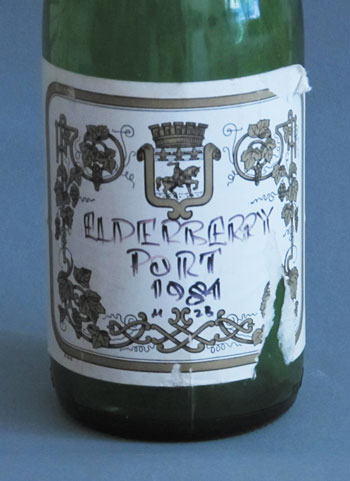In my earlier days I lived in a couple of houses that boasted large cellars. As those were the intoxicating days when there was an explosion of winemaking in kitchens across the country, I decided to make good use of those cellars. Not grape wine, you understand, since that was almost unknown in England at the time . . . but rather fruit wines.
We used mainly hedgerow fruits such as blackberry, elderberry, rose hip, as well as some flowers, particularly elderflower. We pestered local inns and restaurants for discarded wine bottles; we bought bins, tubing, fermentation locks. We discussed with fellow enthusiasts esoteric matters such as the right temperature for fermentation and the best corks to buy. And I had a wonderful find at a local second-hand store — some large wire wine racks, enough to store some 30-dozen bottles. Life was exciting.
This wine is 36 years old, I think I can safely say that it has now matured.
A particular batch has stayed in my memory; it was an elderberry wine in fact. One day as I entered the cellar I smelled the unmistakable odor of fermentation — but I had nothing actively fermenting at the time. Looking along my rows of wine-racks I found the culprit. One of the bottles had popped its cork spewing most of its contents onto the floor — hence the rich aroma. It had fermented for a second time in the bottle with inevitable consequences. On checking the rest of that “vintage” I found that most of the bottles had started to push out their corks; the whole batch had started to re-ferment!
I remembered reading somewhere that Port makers, when the timing is right, add brandy to their must to arrest the fermentation. Capitalizing on this shred of knowledge I uncorked them all, gently pouring the contents into a large container. My slender knowledge did not include anything relating to the amount needed so I guessed, buying a couple of bottles of inexpensive brandy that I proceeded to add to the wine. My theory was correct and the bubbles soon stopped forming. This addition obviously changed the overall character of concoction. And so of course I renamed it — Elderberry Port.

We now “fast forward” to last week. I have got rather older and no longer make wine and have moved houses, two or three times in fact, since that Elderberry Port. As a result, my wine cellar these days is a much more modest affair, just a wooden rack for a dozen bottles sitting in our store cupboard. Anyway, last week my wife told me that one of the bottles was leaking. Naturally, I did not want to waste any and so looked into it right away. Fortunately it was just a small seepage so no harm was done. I wiped up the mess and took out the offending bottle. It proved to be one of my own homemade wines.
Ah, but the irony of it. The bottle was one of the batch that had popped its cork in earlier days! I had held onto a couple of bottles, moving them from house to house, thinking they would be suitable for some celebration; but none seems to have arisen. Of course, the leaking bottle had to be uncorked and so now was obviously the time to decant and taste it. Nectar! I would liken it to something between a sweet sherry and a tawny port. Certainly a drink to be sipped and savored, not knocked back like I used to do with many of my other homemade wines.
But the really interesting thing is the label. It reads “Elderberry Port 1984”. This wine is 36 years old, I think I can safely say that it has now matured. Maybe the occasion to open the last bottle will be next month, to celebrate my ninetieth birthday.







